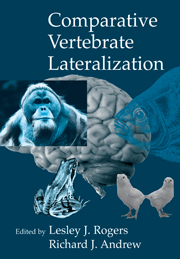Epilogue
Published online by Cambridge University Press: 10 December 2009
Summary
Recent progress in our understanding of cerebral lateralization in vertebrates, as a whole, has been striking. The field has moved from studies designed only to show whether asymmetry of some sort is present in a range of different species to research extending knowledge of the most basic features of lateralization and the conditions under which they probably evolved and in which they develop. The flowering of studies on fish has brought better understanding of the conditions under which lateralization may have first evolved. Major advances (and surprises) are bound to come from a full elucidation of the asymmetries of the brain of Amphioxus, and perhaps the central nervous system of other primitive chordates. Although functional (and behavioural) studies remain to be done, the mere existence in Amphioxus of a direct input from the homologue of the paired eyes of vertebrates to motor mechanisms, which exists only on the left side of the brain, is enough to push our evolutionary horizon back to beyond the origin of the vertebrates.
At present, the clearest hypothesis, which might guide new research, is the proposition that the basic properties of cerebral lateralization are present and similar throughout the vertebrates. This now calls for rigorous testing. Past experience shows that it is not enough to fail to find any evidence of asymmetry in a single type of test (particularly behavioural).
- Type
- Chapter
- Information
- Comparative Vertebrate Lateralization , pp. 634 - 640Publisher: Cambridge University PressPrint publication year: 2002



